|
|
|
Published
on 21
May 2011
|
All rights reserved.
|
|
Until the mid-1990s,
Honda
was still an engineering-led company with an ambitious mind and strong
motivation for success. Take its Civic for example, it introduced a new
generation every four
years, and each generation brought the world some of the most
edge-cutting technologies. Somehow, the rising trend came to a halt as
Japan fell into a long recession. Then it was hit by the strength of
yen, the emergence of Korean competitors and, lately, the revival of
Detroit. These unfavourable factors stretched its resources
thin, limiting the progress it can make.
The 9th generation Civic was born under such circumstances. Honda still
managed to keep a relatively short turnaround cycle of 5 years (the
last gen was born in early 2006), but the result is the mildest
progress we have ever seen in its 40 years history. In fact, keeping
much the same styling, interior, chassis and powertrains, we may even
describe it as a light evolution of the old car. Fans of Civic might
feel being cheated.
The Civic sedan reviewed here looks remarkably close to the outgoing
car. Not only its length, width and height are practically unchanged,
it also
carries over the monospace profile with fast A-pillars, huge
windscreen and very short bonnet. There are some refinement though –
the bumpers and shoulders are more sculpted, the waistline rises
slightly towards the tail, the nose grille and headlights are made less
flush with the body in order to shout for their existence. However, the
benefits these changes bring are not too obvious, and some even work
against it. For example, the new shape taillights look
out of place with the rest of the design. There seems to
be less coherence between the old and new elements. While the old car
was all about futuristic, the new car dials back with some
conservatism. The result is a mixed impression.
Inside, we are displeased to see the return of the two-tier dashboard.
On the one hand its contribution to ergonomics is questionable, on the
other hand it looks really ugly. Its blocky design looks outdated, so
do the switch gears and
the lack of quality materials. The interior design, colors and
materials are at least a generation behind the latest European cars
like Volkswagen Golf and Opel Astra. Even the new Hyundai Elantra can
teach the Honda a thing or two. Equipment is equally outdated, as
keyless entry and engine start button are absent here.
Well, the cabin is not all that bad. At least it offers plenty of
space.
Although Honda has shortened the new car's wheelbase by 30 mm to 2670
mm, it is still a generous dimension by class standard (only fall short
of Hyundai Elantra's 2700 mm and Chevrolet Cruze's 2685 mm). Moreover,
engineers managed to squeeze more room out of the body shell, so the
rear seat actually gains 40 mm more legroom, while shoulder room gets
a massive boost of 74 mm. Overall, the whole cabin is 4 percent bigger
than before, according to America's EPA measurement.
Thanks to
large glass area, the cabin feels light and airy. By using more
high-strength steel
to construct the chassis, Honda managed to slim up its A-pillars,
improving
visibility, while making the body-in-white 7 percent lighter and 10
percent
stiffer. Aerodynamic drag is lowered slightly too. All these
improvements are
small but nonetheless they point to the right direction.
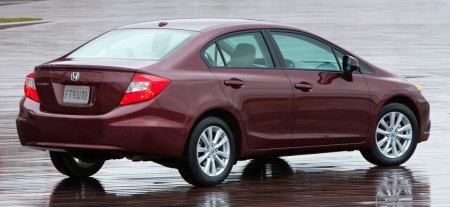
They need
to,
because the new Civic has no fundamental changes to its driving
hardware. The 1.8-liter
SOHC i-VTEC engine received only minor modifications to reduce friction
and fuel consumption, but its failure to offer direct injection and
all-valve variable cam phasing costs its output, which remains
unchanged at 140 hp and 128 lbft. Honda claims it now offers more
mid-range torque between 2000 and 4000 rpm, but in reality the gain is
too small to mention, so its performance falls slightly behind the
class standard. For a car used to be renowned for advanced engine and
brisk performance, how can we not disappointed ? Also carried
over is
the 5-speed automatic gearbox, which is a ratio short of the industrial
norm.
To squeeze more miles out of each gallon of fuel, Honda has remapped
the gearbox to promote
the use
of higher gears. This can hardly satisfy keen drivers, of course.
However, what disappoints keen drivers most is the steering, because it
has been retuned to be slower and more isolated (numb) in the name of
higher refinement. In this way, the Civic can no longer attract keen
drivers like the last generation did. It feels boring to drive.
On the positive side, the new car is undeniably more comfortable, with
a smoother and quieter ride, and a better isolated cabin. The stiffer
chassis, more sound deadening and a longer travel suspension setup
contribute to this refinement. Just like a 40-year-old man, the new
Civic trades much of its athletic character for a grown-up manner.
Trouble is, no one wants it to be another Toyota Corolla. It's time for
Honda to rethink about its core values. |
Verdict:
   |
Published
on 21
May 2011
|
All rights reserved.
|
|
Civic Coupe Si
|
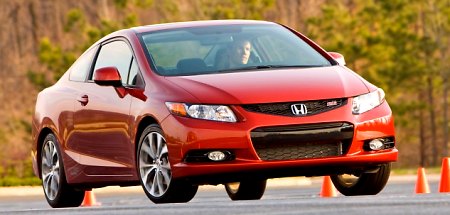
Traditionally,
performance
versions of Civic are highly desirable. Top of the pick is Type R, of
course, but lesser models like Si, SiR or Type S are already exciting
enough to please young drivers, especially considering their room for
modifications. The wide availability of performance components for
Honda's K20 engine is a strong reason to buy sporty Civics.
However, the same cannot be said to the latest Civic Coupe Si, because
it has switched to the larger K24Z7 engine. This 2.4-liter motor has
practically the same specifications as the one serving Acura TSX (i.e.
Japanese and European Honda Accord). Both its VTEC and VTC (variable
cam phasing) mechanism work on the intake valves only. Compression
ratio remains a high 11.0:1, but the larger capacity by means of long
stroke stresses on torque instead of power. The result is a boost of 31
lb-ft, and now the peak torque arrives at 4400 rpm instead of 6100 rpm.
This improves the car's drivability as well as reduces fuel consumption
a little. On the flip side, the larger engine redlines at only 7000
rpm, a full 1000 rpm lower than before. Its maximum output barely
inches up by 4 horses to 201 hp.
Worse still, the K24Z7 cannot interchange parts with hot versions of
K20, because its camshafts are longer and its exhaust manifolds are
integrated with the cylinder head. This seriously limits its
tunability, thus will put off many boy racers.
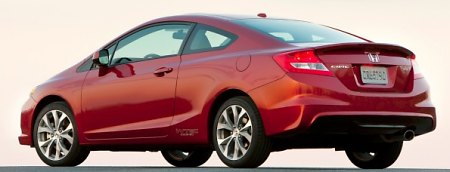
On the road, the wider power band of new engine does feel more useful,
allowing you to make less gearshifts. In-gear acceleration is more
responsive, even though standstill acceleration and top speed show no
obvious progress. However, keen drivers would actually prefer to use
more the 6-speed manual, whose shift action is as slick and short as
before (because it is carried over from the old car). They would also
prefer a more thrilling experience from the engine, accessing its
ultra-high rev and listen to the switchover of VTEC cams. In the new
car, these thrills have been largely reduced, sadly.
The rest of the car shows a similar story to the Civic sedan. We don't
understand why Honda decided to slower its steering ratio from 13.6:1
to 16.1:1. This results in a laughable 3.1 turns from lock to lock,
robbing the car a sharp turn-in. The electrical power steering also
feels lifeless, especially at the straight ahead position. In short,
the steering is significantly poorer than the old car.
The new Coupe runs a 2620 mm wheelbase, 50 mm shorter than the sedan
and 30 mm shorter than the old Coupe. Si still gets the old car's
helical limited slip differential to help it put down the power
effectively. The same 215/45ZR17 tires provide traction and grip. As a
result, the handling (save steering) is remarkably close to the old
car. The only noticeably area is ride quality and quietness, thanks in
part to a stiffer chassis.
Not only the dynamic aspect is disappointing, the packaging is the
same. The new Coupe is an ugly duck, more so than the previous car. Its
monospace shape with short bonnet and high fastback looks more like a
Toyota Prius than a sporty coupe. The waistline looks too high, the
nose looks a mess and the tail is characterless. Inside, the cabin is
dominated by an ugly, low-rent double-decker dashboard like the sedan.
Few coupes these days look as undesirable. Moreover, the fastback eats
into rear headroom, limiting its usage to children. When you can buy
desirable hot hatches like Golf GTI and Scirocco, there is no reason to
choose the Honda. |
Verdict:   |
Published
on 16
Nov 2011
|
All rights reserved.
|
|
Civic hatchback (Europe)
|
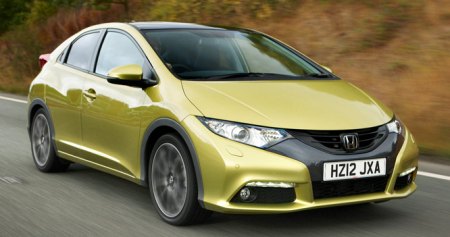
We know the new
Civic
sedan is a light evolution from the last generation. How about its
European hatchback sister? Much the same story. Although you can name a
lot of small changes, such as a 30 mm shorter wheelbase, slightly
altered exterior dimensions (30 mm longer, 20 mm lower and 10 mm wider)
and all new body panels, the car still looks remarkably close to the
old car, thanks to a radical wedge profile that made the old car so
distinctive. The shape is so familiar that you can easily forget the
restyled nose (with new headlights and a black mask mirroring VW Golf
GTI Mk5) and new taillights. If you notice the new nose and tail, that
is only because they are less easy to eyes than the old ones.
Style-wise, this is not a successful revision.
I don't understand why Honda decided to shorten its wheelbase while
everyone else is lengthening. It appears that the only reason is to
keep the hatchback's wheelbase 65 mm shorter than the sedan's like the
last generation. Fortunately, the old Civic hatchback had a spacious
rear passenger compartment, so the loss of 30 mm has not hurt it too
much. There is still useful space for tall adults. Moreover, the boot
remains a commanding 487 liters thanks to its unusual height.
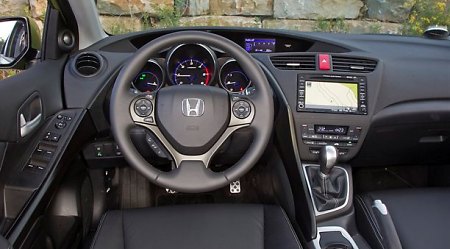
The radical dashboard remains. It still employs a two-tier, aircraft
cockpit architecture. Good news is the digital instrument readings have
been replaced with conventional gauges for better ergonomics. Materials
have also been improved, with soft-touch plastics used on most surfaces
you are likely to touch – something clearly better than its sedan
sibling. On the downside, rearward visibility is still hampered by the
split hatchback window and thick C-pillars.
As before, the hatchback employs torsion-beam suspension at the rear
instead of the sedan's multi-link setup to free more space from the
cabin and boot. This explains for its superior space efficiency and, in
combination with the central-mounted fuel tank (located under front
seats), a rear bench that can not only fold flat but also flip up like
cinema seats to place tall luggage in the cabin. Honda hasn't altered
this feature since the old car. It doesn't need to, as no rivals can
match it yet.
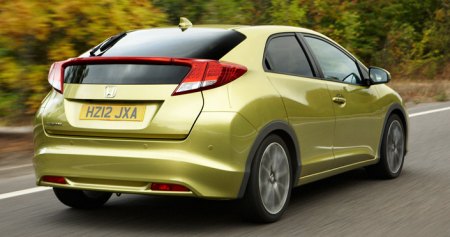
The powertrains are also largely unchanged - the 99hp 1339 cc 8-valve
and 140hp 1.8-liter 16V i-VTEC produce the same output as before, only
the 2.2 turbo diesel gets an extra 10 hp to 150 hp. However, the
expensive diesel is not going to account for too many sales, as it is a
mismatch to this class (remember, it was originally designed for
Accord; Honda has yet to build a small diesel motor for European
market). The majority sales will go to the 1.8 petrol. It is not a bad
motor, but the lack of turbocharging torque means you need to work hard
on gearshift to overtake and, as a result, you have to tolerate with
the excessive engine noise at higher rev.
That is a pity, because otherwise the Civic hatchback goes quite
refined. Honda has listened to criticisms to the old car and spent
extra efforts to solve its NVH problems. The torsion-beam suspension
has been given softer springs and hydraulic bushings. Thicker windows,
reinforced door seals and extra sound deadening materials also help
cutting NVH. The result is much reduced road noise and harshness on
motorway cruising. Its rolling refinement is definitely improved a lot,
but it is not perfect yet – on harsher B-roads the suspension still
delivers poorer primary ride than what you will find on Golf, Focus or
many European rivals.
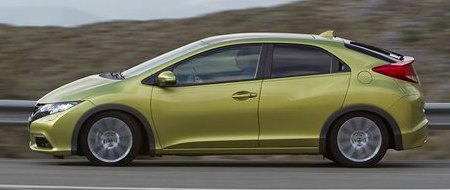
The softened suspension has little adverse effect on handling, but the
new steering does hampers the old car's sporty character. Although it
is still a pure electrical power steering, the mechanism is said to be
new. With 2.5 turns instead of 2.9 turns from lock to lock, it is even
quicker than before. It is also more linear and accurate. However, the
steering is made lighter – good for regular urban driving but too light
for the taste of keen drivers – and it does not deliver much feedback
to involve the driver. As a result, the new car is actually less
entertaining to drive than the old car.
Overall speaking, the new European Civic hatchback has taken a small
step forward, but such a small step is not enough to challenge the best
of the class, especially when the improvements are accompanied with
some compromises hard to ignore. |
Verdict:    |
| Published
on 26
Dec
2011 |
All rights reserved.
|
|
Civic Hybrid
|
The last generation
Honda
Civic Hybrid was a compromised package, no matter in terms of
technology, fuel economy or driving dynamics. The new car tries to
improve these areas and close the gap from Toyota Prius. Nevertheless,
judging from the measures it has taken, I doubt if it will succeed.
Honda thought a larger petrol engine would give it better performance,
but pumping the 1.3-liter SOHC 8-valve engine to 1.5-liter alone won't
solve the problem. Its tuning is still oriented to fuel economy – as
before, the so-called i-VTEC system has no variable cam phasing, just a
3-stage VTEC with a set of slow cams, fast cams and zero-lift cams (for
deactivating the cylinders in EV cruise). It even lacks the 4-valves
head of CR-Z. Horsepower is actually reduced a little bit to 90 hp,
although max torque is improved slightly to 97
lbft.
To improve fuel economy and stretch the availability of electric mode,
the DC motor is strengthened to produce 23 hp and 78 lbft instead of
the outgoing 20 hp and 76 lbft. Such improvement is equally subtle. A
better news is the NiHM battery has been replaced with Li-ion, whose
higher energy density allows a smaller and lighter package. Having said
that, the trunk of Civic Hybrid is still no match with that of Toyota
Prius.
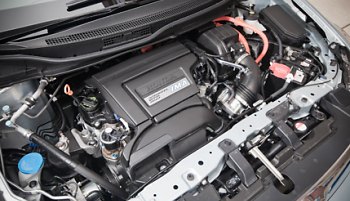
Honda's IMA (Integrated Motor Assist) system has its thin electric
motor sandwiched between the engine and CVT, and the motor is
permanently connected to the engine without clutch. Therefore the
engine still spins and wastes energy when the electric motor propels
the car alone. This means it will never match Toyota's HSD (Hybrid
Synergy Drive) for efficiency. Moreover, its sole electric motor is
responsible for both propulsion and regeneration, unlike HSD which uses
a motor for propulsion and another motor dedicated to regeneration, so
its energy recoverage is not as efficient as Toyota's. Furthermore, the
Honda's EV mode is only available when the car is on light cruising. It
cannot pull the car from start, unlike most other hybrids.
On the road, the new Hybrid does deliver improved mpg over its
predecessor, although its EPA rating still lags behind Prius (44 mpg vs
51 mpg city; 44 mpg vs 48 mpg highway). The gain in performance is
negligible, as it still takes more than 10 seconds to go from zero to
sixty. The regular 1.8-liter Civic is still a better companion if you
want a brisk drive. In terms of ride and handling, it feels like a
normal car, albeit with an abrupt brake pedal (due to regenerative
braking) and less grip (due to low-rolling resistance tires). Therefore
it is a little bit more enjoyable to drive than Prius. On the downside
is refinement. Its engine-motor integration is not the best in hybrid
world, with noticeable vibration and noise whenever the engine cuts in.
In the end, the new Civic Hybrid is still a compromised package. As
Toyota is expanding its HSD offerings to smaller cars, Civic Hybrid
will find life getting harder and harder. |
Verdict:    |
Published
on 20
Apr 2014
|
All rights reserved.
|
|
Civic facelift
|
|
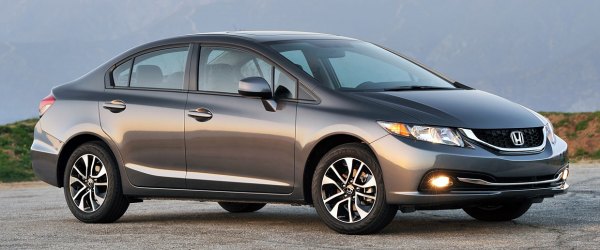
|
When the current generation
Honda Civic went on sale 3 years ago, it caught a lot of criticisms
from magazines like Car and Driver and Consumer Report, blame mainly to
its dull look, mediocre driving dynamics and cheap interior. Honda
realized the problem and immediately started working on improvement.
The result was an early facelift introduced in late 2012. Externally,
it could be distinguished with a slightly smarter front grille.
Internally, the dashboard received higher quality plastics while a few
places, such as center console and air vents have been restyled, though
it still looked too complicated and far from tasteful. Meanwhile,
chassis dynamics was sharpened by stiffening the suspension springs,
bushings and anti-roll bars. The steering got quicker ratio and reduced
friction. Most models got larger brakes, too. Refinement was improved
slightly by using a stiffer front subframe, more sound deadening and
thicker glass.
This year, Honda added further mechanical upgrades. The 1.8-liter
i-VTEC engine gets freer flowing exhaust hence gaining 3 more
horsepower. The automatic transmission is replaced with a new CVT to
boost fuel economy, but performance remains largely the same. Inside,
the cabin gets improved infotainment system, some new equipment and
better trims to match the competition. Overall, the new car is
considerably better to drive and to travel than the original, but it
still lags a long way behind class leaders like Volkswagen Golf, Seat
Leon, Ford Focus and Mazda 3 etc.
|
Verdict:    |
Published on 7
Jul 2015
|
All rights reserved.
|
|
Civic Type R (FK2)
|
|
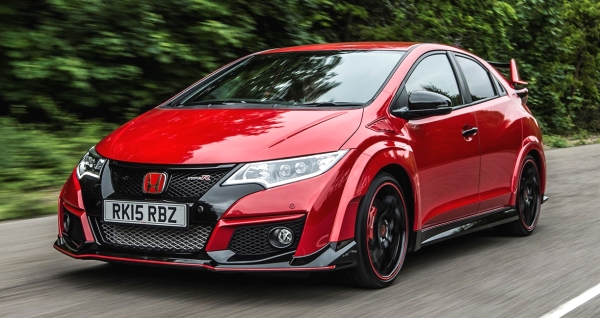
|
There are many highly
respected labels in the hot hatch world, such as GTi, R, RS, OPC or
Cupra. However, in the hearts of hardcore drivers nothing can quite
compare with Honda’s Type R. This badge has always been associated with
the world’s fastest revving engines (thanks to VTEC), excellent
gearshifts, superb seats and hardcore chassis tuning. Since 1997, Honda
built 3 generations of Civic Type R,
with the last introduced 8 years ago. Glorious history, but doesn’t it
sound a bit distant in 2015? Well, the hot hatch world has undergone
fundamental changes in the past few years. Competition has never been
so intense. Now 300 horsepower becomes the norm, while
sophisticated suspensions, 4WD and electronic differentials
become
increasingly popular. The old Type R formula seems a bit outdated in
comparison. Having rested for too long, it is time to reinvent the Type
R.
In the making of the fourth generation Civic Type R, chief engineer
Hisayuki Yagi san decided to overhaul its strategy. The new car is
derived from the European Civic hatchback and therefore built in the
Swindon plant in UK. Sadly to some fans, there won’t be a Japanese-spec
sedan anymore, as Japan will import the hatchback from UK. However, the
really big news is the abandoning of high-revving naturally aspirated
engine for a new 2.0-liter turbocharged motor, just like most rivals in
Europe. Its hardcore fans will be definitely disappointing, but this is
admittedly a must to deliver the power output necessary to compete.
Apart from engine, the new Type R also shows significant upgrades in
suspensions and aerodynamics. The aim is to be the fastest hot hatch
lapping Nurburgring Nordschleife, a title held by Renault Megane RS275
Trophy-R at 7 min 54.36 sec. The car was developed as much in Japan
(especially for powertrain and aerodynamics) as in Europe (chassis and
track
testing). Ridiculously, its engine is built in the engine
plant at Ohio, USA, showing the multinational facet of Honda today.
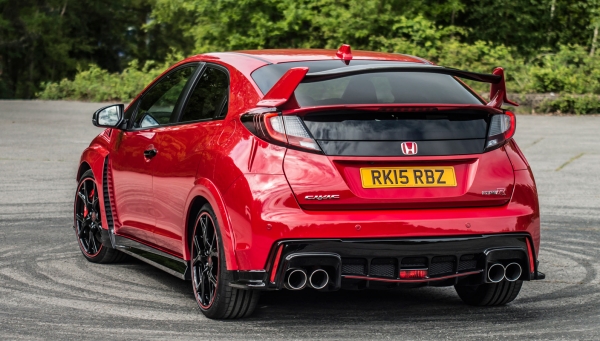
|
Before looking at its new motor, we should talk about its striking
exterior first. With massive air dam, skirts, extended wheel arches,
large diffusers, quad-exhaust and that huge rear wing, this is easily
the most aggressive looking hot hatch at present. It even reminds us
the days of Sierra and Escort RS Cosworth, when boy racers shouted
loudly
about their performance purchase. Striking aside, the Civic Type R
is by no means a beautiful car. As always, the MPV proportion
inherited from the European Civic hatchback means it is an ugly duck.
Even give it wings would not turn it into a swan. A fighting duck at
best.
Almost the same story can be told for the interior. The red Recaro
buckets are eye-catching and superbly supportive. They are just mounted
too high to feel sporty. Even though they are already lowered by 30 mm
compared with the standard Civic, the driving position is still more
MPV than sportscar-alike. The 2-tier dashboard is as flawed as before,
as the instrument
is split by the steering wheel rim. The plastics and switches are
ordinary in quality, which is a disappointment when you realize the
same money can buy German hot hatches with premium quality. On the plus
side, all the key driver controls are precise and have good weight.
The aluminum spherical gear knob, another trademark of Type R, looks
delicious and feels great in hand. Yes, this Honda keeps using
old-fashioned 6-speed manual gearbox while many rivals have turned to
faster responding dual-clutch transmissions. This inevitably hurts
outright performance a little, but as usual the Honda box has near
perfect gearshifts, i.e. slick, short and precise. Keen drivers will
not mind to sacrifice a couple of tenths in 0-60 mph for the extra joy
and engagement it brings. Less committed drivers might prefer the ease
of use of DCT, but then they are not the target audiences of Type R.

|
However, the highlight is still under the bonnet. Generations of VTEC
motors set us on fire with 8000 or 9000 rpm capability. Can Honda’s new
VTEC turbo overcome the shortcomings of turbocharging and result in a
miracle? Let’s look at its specifications first. The 1996 cc DOHC
four-cylinder is
an all-alloy design, with cast aluminum pistons, head and block. Forged
connecting rods and the crankshaft are lightweight items, too. Being
part of
the “Earth Dream” family, it is the first ever Type R engine fitted
with direct injection and turbo. The combination of direct injection,
sodium-filled exhaust valves and improved water jackets at the cylinder
head allows a higher, 9.8:1 compression ratio for better thermal
efficiency and off-boost performance. As expected, the Honda motor
features dual-variable cam phasing (VTC) and trademark VTEC variable
valve lift. However, unlike the case of naturally aspirated
applications, the VTEC mechanism here is used at the exhaust side. Its
purpose is not to boost power but to reduce turbo lag (note: on a
forced induction engine, VVL does not bring much rewards in power
output because, with
the present of boost pressure, the limiting factor of power output is
no longer valve
lift). At
low rev, the exhaust valve VTEC switches to high lift to increase
exhaust gas
pressure, therefore helps spinning up the turbine more quickly. At
higher rpm where exhaust pressure is already built up, it reverts to
low lift setting. In this way, Honda said it has achieved a good
balance between low-end response and high-end power.
On paper, this looks to be only partially successful. With 310
horsepower released at 6500 rpm, its maximum power is undeniably
outstanding. It is easily more than Renaultsport Megane (275 hp), Seat
Leon Cupra (280 hp) and even Golf R and Audi S3 (both 300 hp). In fact,
among all production 2-liter class rivals, only the higher-boosted
Mercedes A45 AMG trumps it. Its max torque of 295 pound-foot is also
exceptional. Nevertheless, that peak torque is available from 2500 to
4500 rpm, which is not as low or as wide as expected. For example, Golf
R has its max torque available from 1800 rpm all the way through 5500
rpm, although its peak value is a little lower at 280 lbft. The
outgoing A45 AMG offers 332 lbft from 2250-5000 rpm. The benefit of
VTEC is not obvious, at least from these numbers.
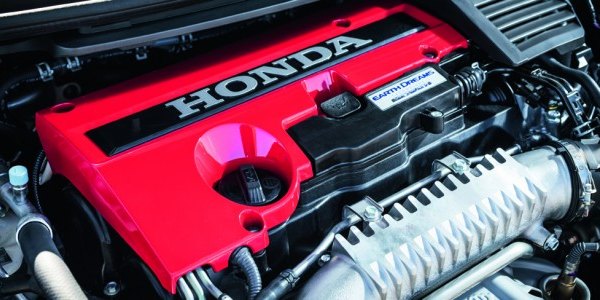
|
In the real world, the VTEC turbo also displays more lag than the
mighty Golf R, whose engine is smoother, more responsive and nearly as
powerful. The Type R's power delivery is strong but it is also strongly
concentrated at the mid-range. It needs north of 3000 rpm to fly. If
you are committed to the driving, you will find it very fast. Forget
the 0-60 mph quote of 5.4 seconds. It feels faster than that, faster
than Megane RS275 in the straight line and well matches the Golf R. The
fact that it trails the latter in numbers is mostly down to the
front-wheel drive.
Unfortunately, in the pursuit of speed, the CTR has lost its
traditional attraction: high-revving fun. Its fuel cut-out point drops
to 7000 rpm, just a tad higher than its turbo rivals. The lack of rev
to play and the coarse soundtrack at top end make a big difference in
emotion. While BMW M3 and Ferrari 488 GTB manage 7600 and 8000 rpm
respectively with their turbo engines, Honda is not doing the
best job.
But its aerodynamics is definitely the best among hot hatches. No
rivals could do 167 mph (270 km/h) like it, because they lack the Type
R’s massive aero kits, including flat underside, functional diffusers
and pressure-relieving vents on front fenders. Extensive fluid dynamics
modeling and wind tunnel testing at Japan HQ resulted in low drag and
negative lift at both axles, which is unique in the hot hatch class.
The chassis is also a big step forward. Its body is strengthened
by 18% thanks to the use of adhesives and optimized bracketing. To deal
with torque steer, Honda developed a new Dual-Axis Strut front
suspension, which cuts King-pin offset from 60 to 40 mm hence torque
steer by 55 percent. In other words, it is an equivalent of
Renaultsport's PerfoHub, Ford's RevoKnuckle or Opel’s HiPer strut. At
the rear, the torsion beam is now made of crushed pipes to improve roll
stiffness by 177% (sadly, a multi-link arrangement would not fit).
Moreover, the suspensions have added adaptive dampers which allow
independent and continuous control of each wheel to enhance
roadholding. The suspensions ride on 19-inch alloy wheels and bespoke
235/35 tires. The front and rear tracks have been widened, which
necessitate extended fenders made of aluminum. The car is also fitted
with stronger Brembo brakes, especially the front with 350 mm
cross-drilled discs and 4-piston calipers. The steering employs more
sophisticated dual-pinion electrical assistance. As expected, different
systems are linked up by a control. By pressing a button marked "+R",
you will get faster throttle response, stiffer suspension, heavier and
tighter steering, though no more exhaust noise as it is not variable.
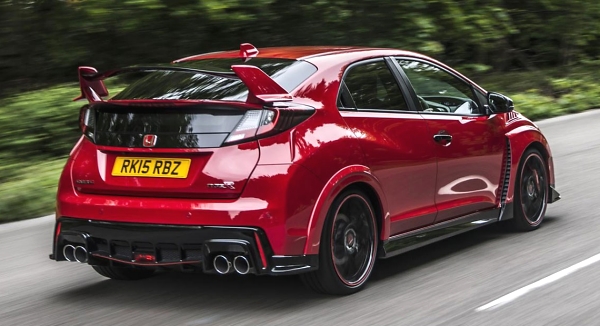 |
The new Type R also features a helical LSD between the front wheels,
which is said to be worth 5
seconds a lap in Nurburgring. A pre-production prototype – discarded of
air-con, audio and front passenger seat to offset the weight of roll
cage, but otherwise said to be the same as final production car –
eventually lapped Nurburgring in 7 min 50.63 sec, a new record for hot
hatches as
well as front-wheel-drive cars. With a powerful engine, extensive
chassis modifications and
advanced aero, no doubt the Civic Type R is the fastest hot hatch on
track. The real question is, is it also the fastest and the best
driving hot hatch on country roads? That is more difficult to
answer. Firstly, its aerodynamics doesn’t work at such speeds.
Secondly, the CTR rides pretty hard, stiffer than
Megane Trophy with Ohlins dampers and more so than the absorbent
Golf R. Its composure is more easily unsettled by bumps. This makes its
extra speed, if any, more difficult to access on B-roads. On longer
trips, the excessive harshness and tire roar hurt refinement and make
it a worse companion than the versatile Volkswagen.
The Type R is more like a competition touring car than a conventional
hot hatch. On wide open roads,
it shines with exemplary body control and a rigid chassis. The traction
and grip it offers is excellent. Ditto the brakes. Torque steer is well
suppressed. The steering is fast and accurate but not as feelsome as
Renault’s or Volkswagen’s. It also lacks the mid-corner throttle
adjustability of the duo, as its rear is simply too safe. Ultimately,
the Golf R is both more enjoyable and more comfortable to drive, while
Megane RS275 Trophy is more engaging. The Type R beats both rivals in
power, speed and cornering prowess, but perhaps its tuning is too
committed to setting Nurburgring lap record, it doesn’t drive as well
on country roads where hot hatches are supposed to favour. It is a good
hot hatch, just a bit different to what we expected for the Type R
label.
|
Verdict:     |
|
|
|
|
|
|
|
|
|
|
Civic
sedan 1.8EX
|
2011
|
| Front-engined,
FWD |
| Steel monocoque |
| Mainly steel |
| 4505 / 1755 / 1435 mm |
| 2670 mm |
Inline-4
|
| 1798 cc |
SOHC 16 valves, VVT
|
| - |
| - |
140 hp
|
128 lbft
|
5-speed automatic
|
F: strut
R: multi-link
|
| - |
| 205/55R16 |
1254 kg
|
| 125 mph (c) |
9.0* / 9.1**
|
| 24.9* / 24.7** |
|
Civic Hybrid
|
2011
|
| Front-engined,
FWD |
| Steel monocoque |
| Mainly steel |
| 4505 / 1755 / 1430 mm |
| 2670 mm |
Inline-4 + electric motor
|
| 1497 cc |
SOHC 8 valves, VVT+L
|
| - |
Cylinder deactivation
|
Engine: 90 hp
Motor: 23 hp
Combined: 110 hp
|
Engine: 97 lbft
Motor: 78 lbft
Combined: 127 lbft
|
CVT
|
F: strut
R: multi-link
|
| - |
| 195/65R15 |
1300 kg
|
| 112 mph (c) |
10.1*
|
| 31.8* |
|
Civic sedan Si
|
2011
|
| Front-engined,
FWD |
| Steel monocoque |
| Mainly steel |
| 4505 / 1755 / 1435 mm |
| 2670 mm |
Inline-4
|
| 2354 cc |
DOHC 16 valves, DVVT
|
| - |
| - |
201 hp / 7000 rpm
|
170 lbft / 4400 rpm
|
6-speed manual
|
F: strut
R: multi-link
|
| - |
| 215/45ZR17 |
1316 kg
|
| 143 mph (est) |
6.1* / 6.4**
|
15.7* / 16.5**
|
|
|
|
|
|
Performance
tested by: *C&D, **MT
|
|
|
|
|
|
|
Civic Coupe Si
|
2011
|
| Front-engined,
FWD |
| Steel monocoque |
| Mainly steel |
| 4460 / 1755 / 1397 mm |
| 2620 mm |
Inline-4
|
| 2354 cc |
DOHC 16 valves, DVVT
|
| - |
| - |
201 hp / 7000 rpm
|
170 lbft / 4400 rpm
|
6-speed manual
|
F: strut
R: multi-link
|
| - |
| 215/45ZR17 |
1305 kg
|
| 145 mph (est) |
6.3*
|
| 17.1* |
|
Civic hatchback
1.8EX GT
|
2011
|
| Front-engined,
FWD |
| Steel monocoque |
| Mainly steel |
| 4285 / 1770 / 1472 mm |
| 2605 mm |
Inline-4
|
| 1798 cc |
SOHC 16 valves, VVT
|
| - |
| - |
| 140 hp |
| 128 lbft |
6-speed manual
|
F: strut
R: torsion-beam
|
| - |
| 225/45WR17 |
1280 kg
|
| 134 mph (c) |
9.0 (c)
|
| - |
|
Civic hatchback 2.2i-DTEC
|
2011
|
| Front-engined,
FWD |
| Steel monocoque |
| Mainly steel |
| 4285 / 1770 / 1472 mm |
| 2605 mm |
Inline-4, diesel
|
| 2199 cc |
DOHC 16 valves
|
VTG turbo
|
| - |
| 150 hp |
| 258 lbft |
6-speed manual
|
F: strut
R: torsion-beam
|
| - |
| 225/45WR17 |
1363 kg
|
| 135 mph (c) |
8.1 (c) / 8.3**
|
| 24.0** |
|
|
|
|
|
Performance
tested by: *C&D, **Autocar
|
|
|
|
|
|
|
Civic sedan 1.8EX
|
2014
|
| Front-engined,
FWD |
| Steel monocoque |
| Mainly steel |
| 4557 / 1755 / 1435 mm |
| 2670 mm |
Inline-4
|
| 1798 cc |
SOHC 16 valves, VVT
|
| - |
| - |
143 hp
|
129 lbft
|
CVT
|
F: strut
R: multi-link
|
| - |
| 215/45VR17 |
1300 kg
|
| 125 mph (c) |
8.8*
|
| 24.5* |
|
Civic Type R
|
2015
|
| Front-engined,
FWD |
| Steel monocoque |
| Mainly steel |
| 4390 / 1878 / 1466 mm |
| 2594 mm |
Inline-4
|
| 1996 cc |
DOHC 16 valves, DVVT, VVL
|
| Turbo |
| DI |
310 hp / 6500 rpm
|
295 lbft / 2500-4500 rpm
|
6-speed manual
|
F: dual-axis strut
R: torsion-beam
|
Adaptive damping
|
| 235/35ZR19 |
1378 kg
|
| 167 mph (c) |
5.4 (c) / 5.5**
|
| 13.4** |
|
|
|
|
|
|
Performance tested by: *C&D, **Autocar
|
|
|
|
|
|
|
|
|
Copyright©
1997-2015
by Mark Wan @ AutoZine
|
|